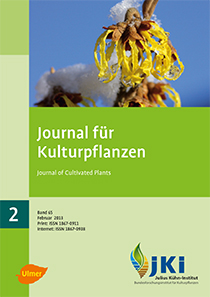Occurrence of foliar diseases and harmful insects as well as strategies of fungicide and insecticide use in sugar beet cultivation in Germany
DOI:
https://doi.org/10.5073/JfK.2013.02.01Keywords:
Treatment index, NEPTUN-survey, Sugar Beet Cultivation-survey, integrated pest management, national action planAbstract
Occurrence of foliar diseases and harmful insects as well as fungicide and insecticide use in sugar beet fields varied in the last decades. This study characterised and analysed changes in the occurrence of harmful organisms and in fungicide and insecticide strategies on regional and national scale in Germany based on data of the Sugar Beet Cultivation-survey (1994–2010) and NEPTUN-survey – Sugar beet (2005, 2007 and 2009). On national scale, the occurrence of foliar diseases spread since 1999 from 50% to nearly the total sugar beet acreage (Fig. 1). Most important foliar diseases in 2009 were cercospora leaf spots and powdery mildew with 70% and 20%, respectively (Tab. 4), whereas other foliar diseases occurred rather on regional scale. Across last 20 years, fungicide use increased from approximately 20% to 80% of the sugar beet acreage and treatment frequency increased up to three applications (Tab. 1). The occurrence of insects varied between 30% and 70% of the acreage, but was controlled often on less than 20% (Fig. 2). In years with a high insect infestation, like 1994, 2008 and 2009, control of insects increased, too. Generally, aphids were the main drivers in insecticide applications (Tab. 5). The number of fungicides and insecticides used per treatment varied close to 1.0 (Tab. 1). Treatment index and treatment frequency varied since 2005 between 0.5 to 0.9 and 0.1 to 0.2 for fungicides and insecticides, respectively. However, treatment index per treatment of fungicides and insecticides was close to 1.0 (Fig. 3). In fields of exemplary regions in the north, west and south, the occurrence of harmful organisms were specified and compared with the used fungicide and insecticide strategies. In 2009, strategies differed in application time and treatment frequency, varying from 0.9 in the North to 2.2 in the South and 0.0 in the South to 0.5 in the North for fungicides and insecticides, respectively (Tab. 4 and 5). Treatment index per treatment was close to 1.0. This and the differences in application time clarify the importance of resistance management and threshold systems in line with the integrated pest management in sugar beet cultivation.
DOI: 10.5073/JfK.2013.02.01, https://doi.org/10.5073/JfK.2013.02.01
Downloads
Published
Issue
Section
License
The content of the journal is licensed under the Creative Commons Attribution 4.0 License. Any user is free to share and adapt (remix, transform, build upon) the content as long as the original publication is attributed (authors, title, year, journal, issue, pages).
The copyright of the published work remains with the authors. The authors grant the Journal of Cultivated Plants, the Julius Kühn-Institut and the OpenAgrar repository the non-exclusive right to distribute and exploit the work.







